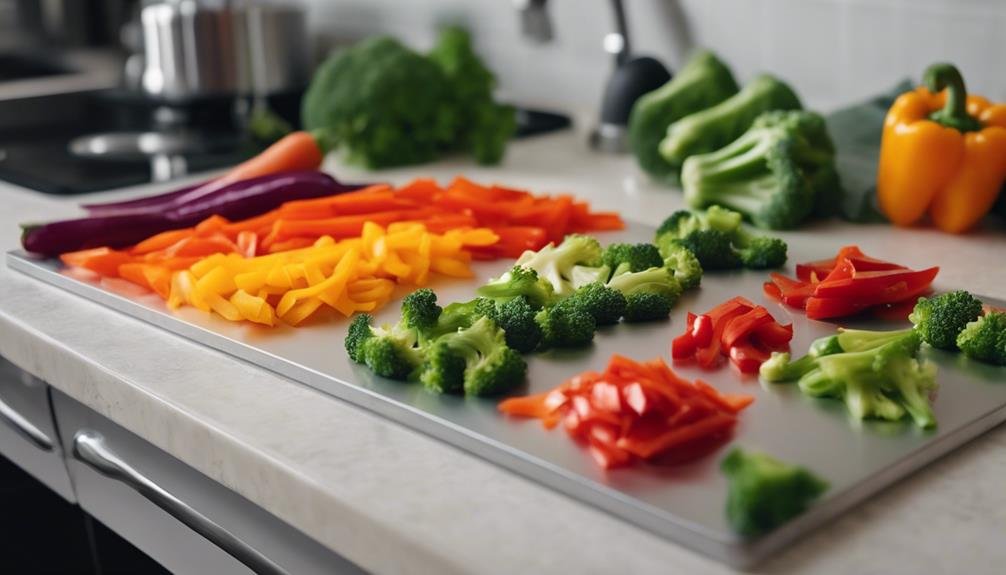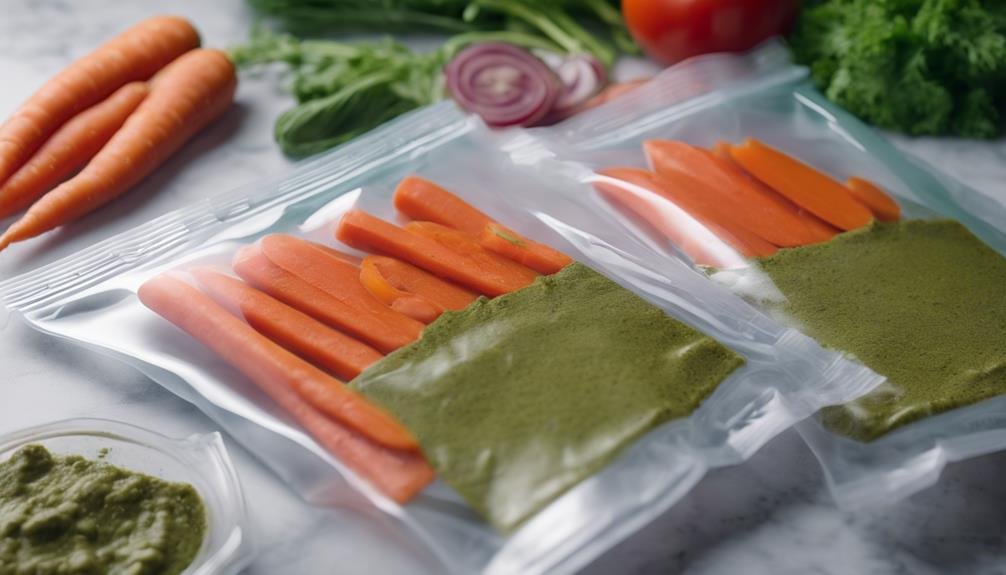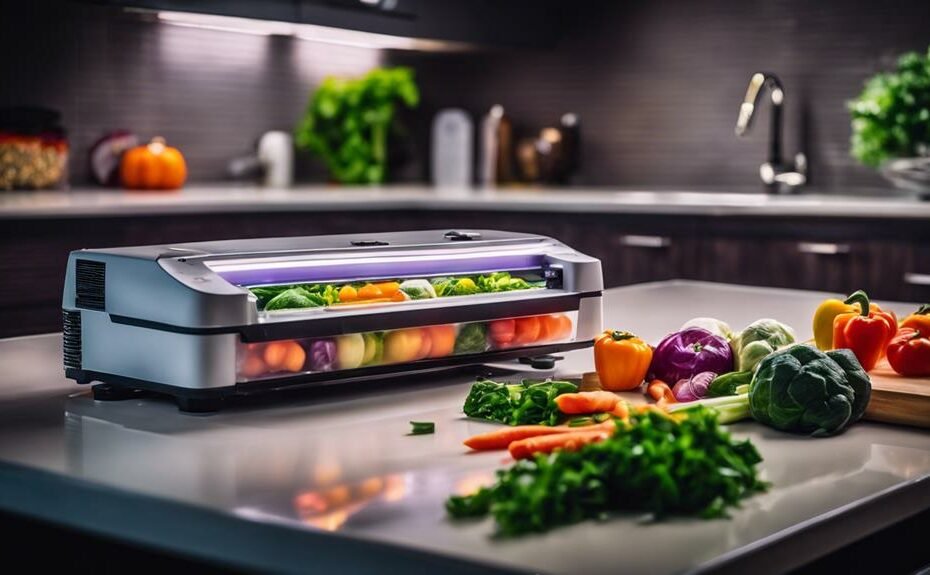Vacuum sealing is an excellent way to preserve your vegetarian meals. It extends shelf life, prevents freezer burn, and maintains freshness for months. You'll need to choose the right vacuum sealer based on your needs and meal prep habits. Properly prepare your vegetables, grains, and legumes before sealing to guarantee maximum nutrient retention. Soups and sauces can also be vacuum-sealed for future use. When storing, label your meals clearly and follow proper storage guidelines. Reheating is simple, whether you prefer sous vide or microwave methods. With vacuum sealing, you'll enjoy delicious, nutritious vegetarian meals anytime. Discover how this technique can revolutionize your meal planning and reduce food waste.
Benefits of Vacuum Sealing Vegetarian Meals
Frequently, you'll find that vacuum sealing vegetarian meals offers a multitude of benefits, from extending shelf life to preserving flavor and nutritional value. By utilizing this method, you can greatly reduce food waste and save money on fresh produce purchases.
Vacuum sealing extends the shelf life of your vegetarian dishes for over six months, ensuring you always have nutritious options at hand.
One of the primary advantages of vacuum sealing is its ability to prevent freezer burn, which can compromise the taste and texture of your meals. This preservation technique retains the freshness and flavor of vegetables, making it ideal for meal prepping.
You'll be able to enjoy home-grown vegetables in your winter meals, guaranteeing a steady supply of flavorful and nutritious options throughout the year.
Additionally, vacuum sealing containers effectively preserve the freshness of vegetarian dishes, preventing them from rotting. This means you can prepare larger batches of meals and store them for extended periods without sacrificing quality.
Choosing the Right Vacuum Sealer
When you're ready to invest in a vacuum sealer for your vegetarian meals, how do you guarantee you're choosing the right one for your needs? Start by considering the size and capacity of the vacuum sealer based on your meal prepping habits. If you're planning to vacuum seal large batches, opt for a model with a larger sealing bar and stronger suction power.
Look for user-friendly features that make the process easier, such as automatic sealing and pulse vacuuming. These can help you achieve the perfect seal for delicate vegetarian ingredients. Also, check if the vacuum sealer is compatible with containers, which can be useful for storing prepared meals or leftover ingredients.
Don't forget to factor in the cost of bags or rolls required for sealing. Some models may be cheaper upfront but require more expensive consumables. Consider the long-term costs when making your decision.
Preparing Vegetables for Vacuum Sealing

Now that you've selected the perfect vacuum sealer, it's time to focus on properly preparing your vegetables for the sealing process. The first step is to thoroughly wash and dry your vegetables, removing any dirt or contaminants that could compromise their quality during storage.
For certain vegetables like broccoli, carrots, and peas, blanching is an important step before vacuum sealing. This process helps preserve their color, flavor, and texture, ensuring they remain as fresh as possible. Different vegetables require specific blanching times, typically ranging from 1-4 minutes. It's important to follow these recommended times to achieve ideal results.
After blanching, make sure to cool and dry your vegetables completely before proceeding with vacuum sealing. This step is essential for maintaining their quality and preventing freezer burn.
Once properly prepared, you can vacuum seal your vegetables, extending their shelf life for over six months. This method not only reduces food waste but also allows you to store fresh vegetables in your freezer, retaining their nutrients for future use in your vegetarian meals.
With proper preparation and vacuum sealing, you'll always have a variety of vegetables ready for your culinary creations.
Sealing Grains and Legumes
You'll find that vacuum sealing grains and legumes is a game-changer for preserving your vegetarian staples. By using this method, you can extend the shelf life of rice, quinoa, and oats by up to two years. It's not just about longevity; vacuum sealed grains and legumes retain their freshness and nutritional value, ensuring you're always ready for a healthy meal.
Legumes like beans, lentils, and even green beans benefit greatly from vacuum sealing. This process prevents insect infestation and moisture damage, keeping your pantry pest-free. You'll no longer worry about weevils contaminating your stored grains and legumes.
Here's a quick reference guide for vacuum sealing common grains and legumes:
| Item | Shelf Life (Unsealed) | Shelf Life (Vacuum Sealed) | Best Uses |
|---|---|---|---|
| Rice | 6-12 months | Up to 2 years | Stir-fries, side dishes |
| Quinoa | 1-2 years | Up to 2 years | Salads, breakfast bowls |
| Lentils | 1 year | Up to 2 years | Soups, curries |
| Chickpeas | 1 year | Up to 2 years | Hummus, falafel |
| Green Beans | 3-5 days (fresh) | Up to 1 year (blanched) | Casseroles, side dishes |
Vacuum Sealing Soups and Sauces

Moving from dry goods to liquid-based dishes, vacuum sealing soups and sauces is an excellent way to preserve your homemade vegetarian creations for future meals. When you use vacuum sealers for these dishes, you're not just storing food; you're locking in flavors and nutrients for up to six months in the freezer.
This method is particularly beneficial for vegetarian meals, as it prevents freezer burn and maintains freshness. To get the best results, invest in high-quality vacuum seal bags that guarantee a tight seal for your soups and sauces. This is essential for preventing any leaks or air pockets that could compromise the quality of your dishes.
As you prepare your meals for storage, don't forget to label and date each package. This simple step will help you stay organized and make meal planning a breeze.
Storing Sealed Meals Properly
Proper storage is the key to preserving your sealed vegetarian meals and maximizing their shelf life. After vacuum sealing your meals, it's important to store them correctly to maintain their freshness and flavor. Always label your sealed meals with the contents and date, making it easy to identify them in the freezer later.
When storing your vacuum-sealed vegetarian meals, keep these tips in mind:
- Make sure the seal is tight to prevent air exposure and freezer burn
- Store meals in the freezer for longer shelf life, up to a year in some cases
- Follow recommended guidelines for different meal types
- Use high-quality bags or containers designed for vacuum sealing
The freezer is your best friend when it comes to storing sealed meals. It extends their shelf life while preserving taste and nutritional value. However, not all vegetarian meals have the same storage requirements. Some may last longer than others, so it's important to research the specific guidelines for each type of meal you're preserving.
Reheating Vacuum-Sealed Vegetarian Dishes

Now that you've learned how to store your sealed vegetarian meals, let's focus on the best ways to reheat them when you're ready to enjoy your homemade dishes.
Reheating vacuum-sealed vegetarian meals is a quick and efficient process that helps maintain the freshness, flavors, and nutrients of your food.
One popular method for reheating is the sous vide technique. Simply place the sealed bag in a pot of boiling water, and let it heat through. This method guarantees even heating and prevents overcooking.
Alternatively, you can use a microwave for faster results. Just remember to puncture the bag slightly to allow steam to escape.
Creative Meal Prep Ideas
When you're looking to spice up your meal prep routine, vacuum-sealed vegetarian dishes offer a world of creative possibilities. By incorporating fresh produce and innovative recipes, you'll not only save time but also enjoy delicious, healthy meals throughout the week.
Consider preparing and vacuum sealing these exciting vegetarian options:
- Colorful vegetable curry with fragrant spices
- Protein-packed tofu stir-fry with mixed vegetables
- Hearty vegetable lasagna layered with seasonal produce
- Flavorful quinoa and bean burrito bowls
Vacuum sealing these dishes prevents freezer burn and maintains their freshness for weeks or even months. This method allows you to experiment with various cuisines and ingredients while ensuring your meals stay as delicious as the day you made them.
Conclusion
You're now armed with the know-how to keep your veggie meals fresh as a daisy.
By vacuum sealing, you'll save time, money, and reduce food waste.
Whether you're meal prepping or preserving garden bounty, this method's a game-changer.
Remember to choose the right sealer, prep your ingredients properly, and store sealed meals correctly.
With these tips, you'll be whipping up delicious, preservative-free vegetarian dishes in no time.
Happy sealing!
